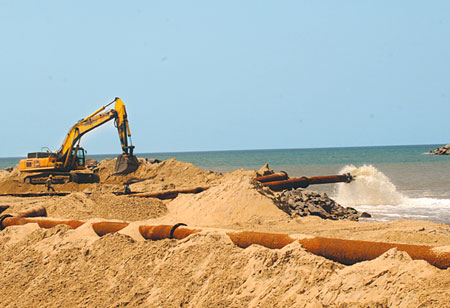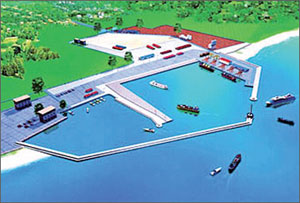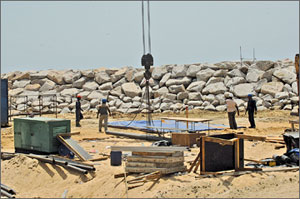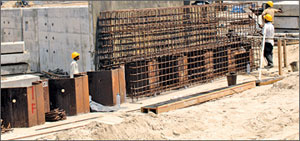|
Milestone in Asian shipping industry :
Two new ports in the offing
By Shirajiv SIRIMANE
 Heralding a new era in the Asian shipping industry, Sri Lanka will
commission two international harbours this year, marking a rare
achievement none of the other Asian countries could even dreamt of. Heralding a new era in the Asian shipping industry, Sri Lanka will
commission two international harbours this year, marking a rare
achievement none of the other Asian countries could even dreamt of.
Sri Lankans can even be more proud that construction of these two
ports, in Oluvil and Hambantota, commenced when Sri Lanka was fighting a
bitter war with the LTTE, emphasising the point that the country did not
compromise development to the war effort.
It is also noteworthy to mention that Oluvil is located in the
one-time war zone and despite such odds the Government went ahead with
the plan to develop Oluvil as an international harbour.
The Hambantota harbour project, which received only lip service for
almost 20 years, finally got off the ground last year mainly to
stimulate the economy of the Southern Province and to raise the living
standards of the less affluent people in the area.
When the ground-breaking ceremony of the Hambantota Port was held,
many said that this project would be confined just to the foundation
stone. However, silencing all critics, President Mahinda Rajapaksa
shouldered the financial burden of the project through assistance from
China.
 |
|
SLPA Chairman, Dr. Priyath
B. Wickrama with President Mahinda Rajapaksa during an
inspection tour |
On August 15, a milestone in the project would be reached with water
being filled to the site.Meanwhile, the Oluvil Port project, begun in
2008 to give further impetus to economic development in the Eastern
region, is now on fast track and has recorded rapid progress with the
first phase to be opened by the end of the year. The Oluvil Port, which
stretches across 1.4 kilometres, will include a commercial harbour and
fisheries harbour.
The Oluvil Development Project received high priority under the
‘Negenahira Navodaya’ program launched to expedite development
activities in the Eastern region.
The Oluvil Port would provide more convenient and cost-effective
access to and from the South Eastern region for goods and cargo
originating on the west coast. International vessels too could patronise
the harbour, thus reducing congestion at the Colombo Port.
In addition, goods would not have to be transported overland, thus
reducing transport costs which would result in the reduction of prices
of essential imported items.

Projected image of the Oluvil port |
 |
 |
 |
 |
 |
 |
| The ongoing
construction at the Oluvil port |
The main construction component of the project is to develop a
commercial harbour with appropriate shore facilities to cater to general
cargo vessels, including coastal passenger transport, with provision for
expansion to a bigger harbour in the future. The fishery harbour will
cater to the requirements of the current and projected fishing
activities and its shore-based services and industries. It will cater to
the needs of the region.
The project also comprises the construction of a commercial harbour
and a basin for fishing craft in the second stage. The permanent
building constructions in the commercial and fishery harbour areas and
the internal and access road constructions are now in progress while
sheet piling and quay wall constructions at the fishery harbour have
been completed; yard filling is also in progress.
The sheet piling, quay wall constructions, land development work and
yard filling in the commercial harbour area of the Oluvil Port are being
carried out.Eighty percent of the construction work of the ice plant at
the fishery harbour is completed.
A total of 912,860 tonne of stones have been transported to the
Oluvil project site.
The benefits of the project have already started trickling in with
many employment opportunities being created. By the end of this year, it
is expected to create 1,000 direct and indirect employment
opportunities.
When the project is completed by 2015, it would open 10,000
employment opportunities. Cement, fertiliser and sugar industries will
be introduced to the region via the new port while the fisheries
industry will also be developed. The private sector too would step in to
provide logistical support, opening up new vistas that were never even
dreamt of a decade ago.
An international port would also woo more foreign direct investments
to the area, resulting the birth of regional industries and opening up
of new markets. The regional communities will receive immense benefits
from the project such as the introduction of cement, fertilizer, and
other industries to the Port, bringing a new lease of life to the
fisheries sector in the region, elevating marketing sector to a higher
standard to give a new impetus to the region’s paddy cultivation and
dairy industry through the improvement of conventional cargo handling
operations.
On completion of the first stage of the commercial harbour it could
handle six vessels of ten thousand tons simultaneously. In addition to
the fisheries harbour, an ice plant with cold storage facilities, fish
auction halls, refrigerated storage, net mending facilities and
administration building and other facilities too would be provided. The
fishery harbour will cater to the requirements of the existing and
projected activities and its shore-based services and industries.
Most of the permanent structures such as administration buildings,
and commercial and fishery harbour are being built at a hectic pace to
meet the year-end deadline.
The total cost of the Oluvil harbour project with financial
assistance from Denmark Government is expected to be around Rs. 6
billion.
During the second phase of the project dredging of the reservoir down
to a depth of 11 meters enabling handling of vessels of 16000 tons and
expanding of the vessel basin up to 24 hectares are expected.
On the initiative and guidance of President Mahinda Rajapaksa, and
the dedication of Sri Lanka Ports Authority (SLPA) Chairman, Dr. Priyath
B. Wickrama, Oluvil Port staff have not left a stone unturned to see the
opening of the Port by the end of this year.
With Colombo South Harbour development project being accelerated Sri
Lanka could entertain hopes for a bright future for its shipping
industry. The proposed harbour will have four terminals each will over
1,200 metres in length to accommodate three berths and provision to
deepen to 23 metres to accommodate deeper draft vessels in the future.
The development of Phase one of the Colombo South Harbour is to be
carried out in two stages. The first stage of the project is estimated
to cost around US$. 300 million local funds. Investment for stage two
with private sector participation would be in excess of US$. 700
Million.
The Galle Port is the only Sri Lankan port that provides facilities
for pleasure Yachts with the International Yacht Society recognising
Galle Port as one of the world’s best attractions.
This was the reason that prompted the government to convert it to the
region’s first tourist harbour. In the next phase, facilities will be
extended to accommodate passenger cruise ships. The project is to be
completed in two stages within three years.
In addition, the government will also develop the Trincomalee Port
while the Kankasanthurai harbour would be developed to international
standards with Indian assistance.
The island nation which had only three main harbours in Colombo,
Galle and Trincomalee for several centuries would soon see three new
harbours being added within a short span of four years. This would
certainly create an unparalleled economic success accelerating Sri
Lanka’s efforts to realise the Wonder of Asia.
|

